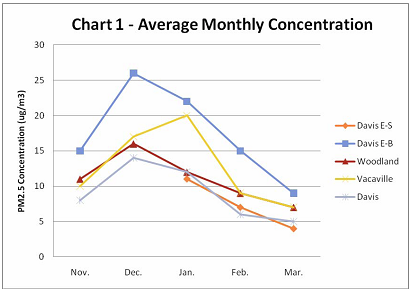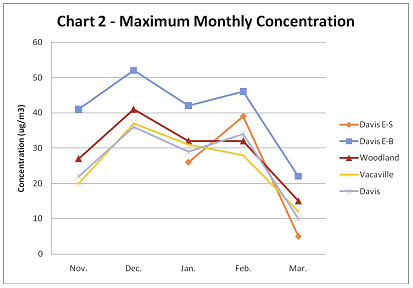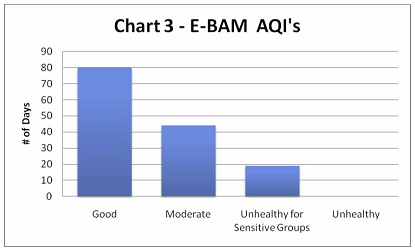 NRC Hears Results of Last Winter’s Davis Wood Smoke Monitoring and Citizen Complaint Studies
NRC Hears Results of Last Winter’s Davis Wood Smoke Monitoring and Citizen Complaint Studies
by Alan Pryor, Yolo Clean Air –
Introduction and Scope of Study – On Monday, May 24, the Davis Natural Resources Commission (NRC) heard the long awaited results of the wood smoke monitoring study conducted by the Yolo Solano Air Quality Management District (YSAQMD) last winter from 11/1/09 – 2/28/10. The report is available through the City of Davis’ website. The purpose of the monitoring study was to determine if particulate matter concentrations in urban Davis were significantly different than those measured at monitors maintained by the California Air Resources Board (CARB) at their permanent stations on the outskirts of Davis, Woodland, and Vacaville.
This study came about because the YSAQMD has consistently maintained that the air quality in the YSAQMD as measured at the CARB monitors is generally well below federal standards for particulate matter less than 2.5 micrometers in size (PM2.5) particulate pollution. This is the particulate size primarily produced by wood burning activities and accounts for approximately 50% of ambient particulate matter in air in Davis during winter months. Others have suggested, and the YSAQMD has acknowledged, that there could be certain parts of residential neighborhoods where excessive wood-burning could result in accumulations of wood smoke that might be in excess of Federal Standards and could result in adverse health impacts.
As a result, in addition to lowering the predicted PM2.5 threshold above which a voluntary “Don’t Light Tonight” alert was called by the YSAQMD last fall (from a predicted 35 ug/m3 to 25 ug/m3), the YSAQMD agreed to coordinate a special monitoring program in urban Davis over the then upcoming wood burning season. This resulted in a temporary monitor installed by CARB on city property in East Davis and a separate temporary monitor installed by the YSAQMD in West Davis. This later monitor had operational problems during the first two months of operation. It was subsequently repaired and moved to a Central Davis location for monitoring during January and February, 2010.
At each temporary and permanent monitoring site, concentrations of PM2.5 were measured on an hourly basis along with meteorological data then the values were stored and retrieved for later analyses.
Results of Monitoring Study
Average Monthly PM2.5 Concentrations – As can be seen from the following graph, the average monthly concentrations of PM2.5 in east Davis averaged from 80-100% higher than those recorded during the same time period in central Davis or west rural Davis and about 33-67% higher than those recorded in Woodland or Vacaville.

Maximum Monthly PM2.5 Concentrations – Maximum recorded concentrations were also substantially higher in East Davis than at any of the other sites.

Number of “Unhealthy Days” in Violation Of Federal Standards – Indeed, the concentrations were so high that on 19 days from November 1 through February 28 (the typical wood burning season), the Federal 24 hour standard for average daily PM2.5 pollution of 35 micrograms per cubic meter (ug/m3) was exceeded and the air was deemed to be “Unhealthy for Sensitive Groups”. By comparison, the number of days in Central Davis and rural West Davis in which air quality was similarly deemed to be “Unhealthy for Sensitive Groups” was only 2 days.

Conclusions Derived from Data – The YSAQMD report submitted to the City simply reported these findings without explanation of the possible causes or public health implications. The following conclusions therefore reflect only the opinion of the author
1) East Davis Air Quality in the Winter is Perhaps the Worst in the Region! – Subject to confirmation by further statistical analysis once all of the raw data is received from study participants, the air in East Davis during the 2009-2010 wood burning season appeared to be among the worst, if not the worst, in the entire YSAQMD and Sacramento AQMD areas.
By comparison, the Del Paso area of Sacramento historically has been designated as the worst area in the entire Sacramento AQMD in terms of wintertime wood smoke particulate matter pollution. Indeed, determinations of mandatory Burn-No Burn days for the entire Sacramento AQMD service area are typically made based on the predicted PM2.5 concentration in the Del Paso area as representative of the worst case scenario in the Sacramento region.
Based on data provided by Dr. Tom Cahill in his coextensive report to the NRC on wood smoke complaints in Davis last winter (see – reviewed in Part II of this series), the Del Paso permanent monitor only recorded 12 days last winter with wood smoke concentrations in the “Unhealthy for Sensitive Groups” range . Thus, the number of days in which air quality deteriorated to the “Unhealthy for Sensitive Individuals” level in East Davis last winter was over 50% greater than the number of unhealthy days similarly experienced in what until then was considered the worst spot in the entire region! This is very, very bad news for asthmatics and seniors in East Davis.
2) Wood Smoke Concentrations in any One Neighborhood are Determined by the Weather and the Number of Wood Burners in the Area and Not By Background PM2.5 Pollution Levels – The wide disparity in concentrations in areas very near to each other and experiencing more or less the same regional background PM2.5 concentrations weather patterns also strongly support the argument by those favoring tighter wood burning restrictions that high levels of localized, neighborhood wood-burning can result in excessively high and unhealthy levels of particulate matter in neighborhoods even when regional or background levels of PM2.5 would not otherwise be considered excessive.
Recommendations –
Given the comparatively very high wood smoke concentrations monitored in East Davis this past winter, it is imperative from a protective public health perspective that additional protective measures be imposed to prevent unhealthy accumulations of wood smoke in winter ambient air. This past year has proven that voluntary wood smoke curtailments now existing do not work in Davis just as they have not worked in any other jurisdiction in California.
Additional Information –
A later article will review the paper submitted by Tom Cahill of the UC Delta Group analyzing wood smoke complaints received by the City of Davis as part of these series of studies last winter (2009-2010 City of Davis Wood Smoke Complaints Study – see the original report).
 NRC Hears Results of Last Winter’s Davis Wood Smoke Monitoring and Citizen Complaint Studies
NRC Hears Results of Last Winter’s Davis Wood Smoke Monitoring and Citizen Complaint Studies 
This study appears to confirm that the smoke problem is localized and that mandatory and draconian blanket city-wide rules are not called for. East Davis has a greater percentage of smaller and older homes with poor insulation than the rest of Davis. For homeowners in E. Davis, burning wood(free) may very well be an attractive if not necessary alternative to high winter PG and E heating bills. Perhaps a less than $50 permit fee for certified clean-burning wood stoves/fireplace inserts, that could then be used to help those who qualify for assistance to replace their current polluting wood-burning system, should be considered.
I would be curious why East Davis has these anomalous results. If an ordinance is enacted, I’d suggest again that Davis simply adopt Sacramento’s ordinance. I’d also suggest an advisory initiative be put on the ballot so the public can consider this issue and vote on it.
Re: “This study appears to confirm that the smoke problem is localized and that mandatory and draconian blanket city-wide rules are not called for.”
This conclusion is not supported by the data presented in the reports. There were only two Davis locations monitored by the YSAQMD monitoring study ( East Davis and Central Davis) so one cannot project the findings of either monitoring series across the entire city and say there is only a problem in East Davis and that the rest of the city is “clean”.
Further, there is actually more evidence showing the wood smoke problem is pervasive and extends across the entire city. Part II of my analysis of the 2009-2010 Davis Wood Smoke studies will be published in the Vanguard shortly and addresses Dr. Cahill’s analysis of wood smoke complaints registered across the City. That study conclusively showed that people registered multiple wood smoke complaints across the entire city – in West Davis, East Davis, Central Davis, and South Davis. And the complaints registered per capita were 6 to 10 times greater than what is similarly experienced in the entire Sacramento AQMD! To me, this sounds like a citizenry that is very adversely affected by wood burning in Davis and wood smoke in Davis is far more than just a “localized” East Davis problem.
While I disagree with a number of Dr. Cahill’s conclusions in his report as will be subsequently discussed, Dr. Cahill did note in his report that there were at least a “dozen cases of credible nearest neighbor impacts” demonstrated in his study. I think it would be grossly unfair to those people in Village Homes who are being bathed in wood smoke and have to tape their doors and windows shut to deny them clean air because they do not happen to live in East Davis.
And the simple fact is that it would be highly problematic and unrealistic to attempt to impose any wood smoke restrictions on East Davis while allowing unfettered serial burning throughout the rest of the City. Mandatory wood burning restrictions are now in place covering from 90-95% of the population from Bakersfield through Sacramento including the entire Bay area. In no cases do the regulatory agencies attempt to impose restrictions on some neighborhoods or even whole cities while not similarly restricting wood burning in adjacent neighborhoods or cities simply because they did not have the opportunity to monitor the air in that particular neighborhood.
The entire region got lucky this past winter as we had a far less than usual number of days with inversion, stagnant air sitting in the valley bowl. West Davis (between 113 and the west city limits) experienced only a very few days where the smoke came out of chimneys slowly drifting sideways in a toxic plume and spreading in circumference until anyone with a pulmonary medical condition walking by had the pleasure of choking and coughing. Some recent winters have had large numbers of such days, varying from nuisance to god-awful, all unhealthy. The science is clear – burning wood pollutes the air everyone breathes. Particulate matter shortens human lifespans and is especially bad for developing lungs (kids) and those with pulmonary conditions. Clean-burning technology is available – it should be mandated as a matter of public health. The argument against mandated clean burning reminds me of the argument against mandatory catalytic converters on automobiles. Can you imagine what our air would look and smell like if we all drove 1960s-era technologies cars? Is Davis really *that* backward, that we refuse to believe what the science tells us and assert our inalienable right to pollute?
I live in east Davis and suffer fron non-allergic vaso motor rhinitis, (translation: stuffy nose 24/7/365 and western medicine can’t do anything for you). That may be considered part of a sensitive group, and yet, I have never experienced any problems with wood smoke in 25 plus years here. Could it be that Prof. Cahill’s meter in East Davis was located in close proximity to some yahoo who burns his garbage in his fireplace, or some other anomaly?
I am surprised to hear that only one location was monitored. We all know that research without significant breadth is generally considered by scientists to be invalid.
Most of east Davis was built by Stanley Davis as a tract, with brick fireplaces that burn too cool to completely combust fuel. I don’t use that inefficient fireplace. I heat with dry wood burned in an efficient woodstove. And I would love to replace my stove with an even more efficient Phase II unit. However I am waiting to make that expenditure until I am assured that the city will not take draconian measures on PM-2 that will curtail my use of wood as my primary heat source.
Roger, your sense of smell must be completely OFF. It’s not just East Davis, it’s all of Davis that’s accosted by people who feel they have the right to emit second hand smoke from their chimneys, without any regard to others. My neighbor’s smoke frequently enters my room.
The study that the district did, was completely inadequate. They didn’t even tell residents that they were performing a study, they sent out no questionaires. There are more than 16 ppl in Davis that complain about the smoke.
What I’m completely flabergasted with is that some of the biggest polluters claim to be environmentalists. Burning your wood is not green, it’s not good for the air, and your comment just shows how ignorant, hypocritical and inconsiderate you ppl are. Why don’t you just get a big ole diesel truck and drive around Davis. Claim your right to drive whatever you want, and blame the environmental problems on every body else, from Obama to China. When are you ppl going to take responsibiity for your actions and stop being such hypocrits?
STOP THE WOOD BURNING. IT’S BAD FOR THE AIR, LUNGS AND THE ENVIRONMENT.
SECOND HAND SMOKE KILLS!!! BE IT FROM A FIREPLACE OR CIGARETTES.